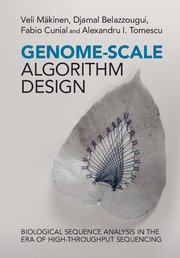Book contents
- Frontmatter
- Contents
- Miscellaneous Frontmatter
- Notation
- Preface
- Part I Preliminaries
- Part II Fundamentals of Biological Sequence Analysis
- Part III Genome-Scale Index Structures
- Part IV Genome-Scale Algorithms
- 10 Read alignment
- 11 Genome analysis and comparison
- 12 Genome compression
- 13 Fragment assembly
- Part V Applications
- References
- Index
10 - Read alignment
from Part IV - Genome-Scale Algorithms
Published online by Cambridge University Press: 05 May 2015
- Frontmatter
- Contents
- Miscellaneous Frontmatter
- Notation
- Preface
- Part I Preliminaries
- Part II Fundamentals of Biological Sequence Analysis
- Part III Genome-Scale Index Structures
- Part IV Genome-Scale Algorithms
- 10 Read alignment
- 11 Genome analysis and comparison
- 12 Genome compression
- 13 Fragment assembly
- Part V Applications
- References
- Index
Summary
Recall the high-throughput sequencing applications from Chapter 1. For example, in whole-genome resequencing we obtain a set of reads, that is, short extracts of DNA sequences from random positions in a donor genome. Assuming that the reference genome of the species has been assembled, one can align the reads to the reference in order to obtain an approximation of the content of the donor genome. We will consider this process in Chapter 14.
We remind the reader that reads come from both strands and, in diploid organisms, from both copies of each chromosome. This means that either the read or its reverse complement should align to the reference genome, but in what follows we do not explicitly repeat this fact. Let us now focus on how to efficiently align a set of (short) reads to a large genome.
The first observation is that, if a position in the reference genome is covered by several reads, one could try to exploit multiple alignment methods from Section 6.6 to obtain an accurate alignment. This gives an enormous semi-local multiple alignment problem with the reads and the reference sequence as input, and a multiple alignment as output (where reads can have an arbitrary amount of cost-free gaps before and after). Owing to the hardness of finding an optimal multiple alignment, shown for example in Section 6.6.3, we leave this approach just as a thought experiment. However, Chapter 14 deals with an application of this idea on a smaller scale.
Let us consider an incremental approach, which consists of aligning each read independently to the reference. This approach can be justified by the fact that, if the read is long enough, then it should not align to a random position in the genome, but exactly to that unique position from where it was sequenced from the donor. This assumes that this position is at least present in the reference genome, and that it is not inside a repeat. See Insight 10.1 for a more detailed discussion on this matter.
Information
- Type
- Chapter
- Information
- Genome-Scale Algorithm DesignBiological Sequence Analysis in the Era of High-Throughput Sequencing, pp. 201 - 219Publisher: Cambridge University PressPrint publication year: 2015
